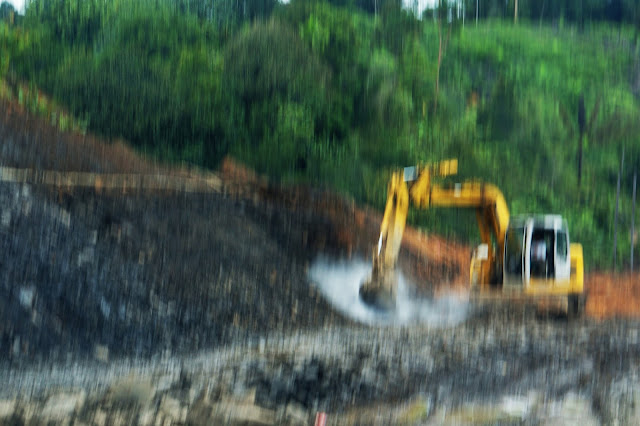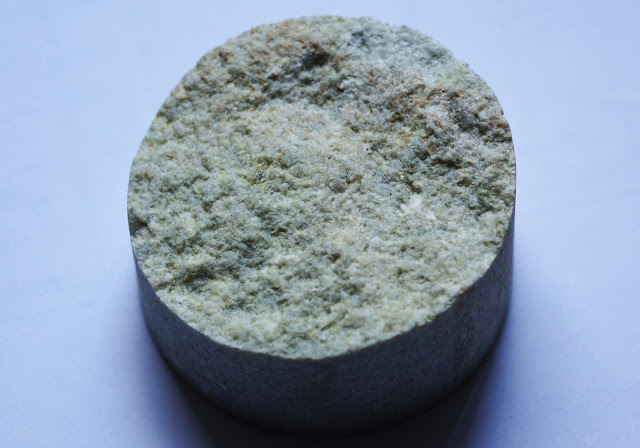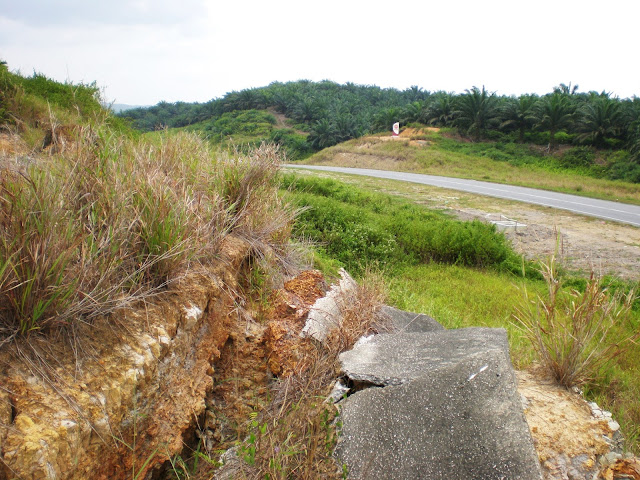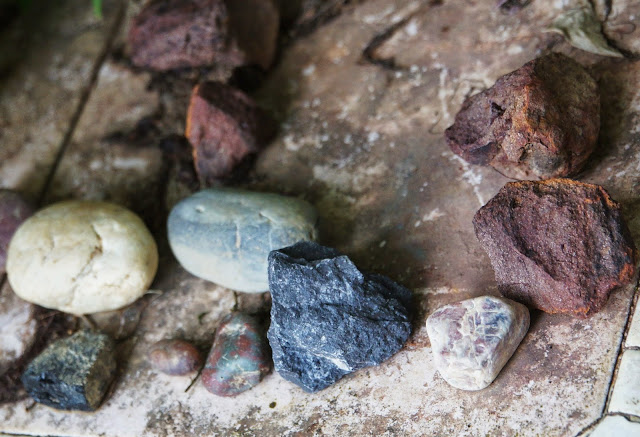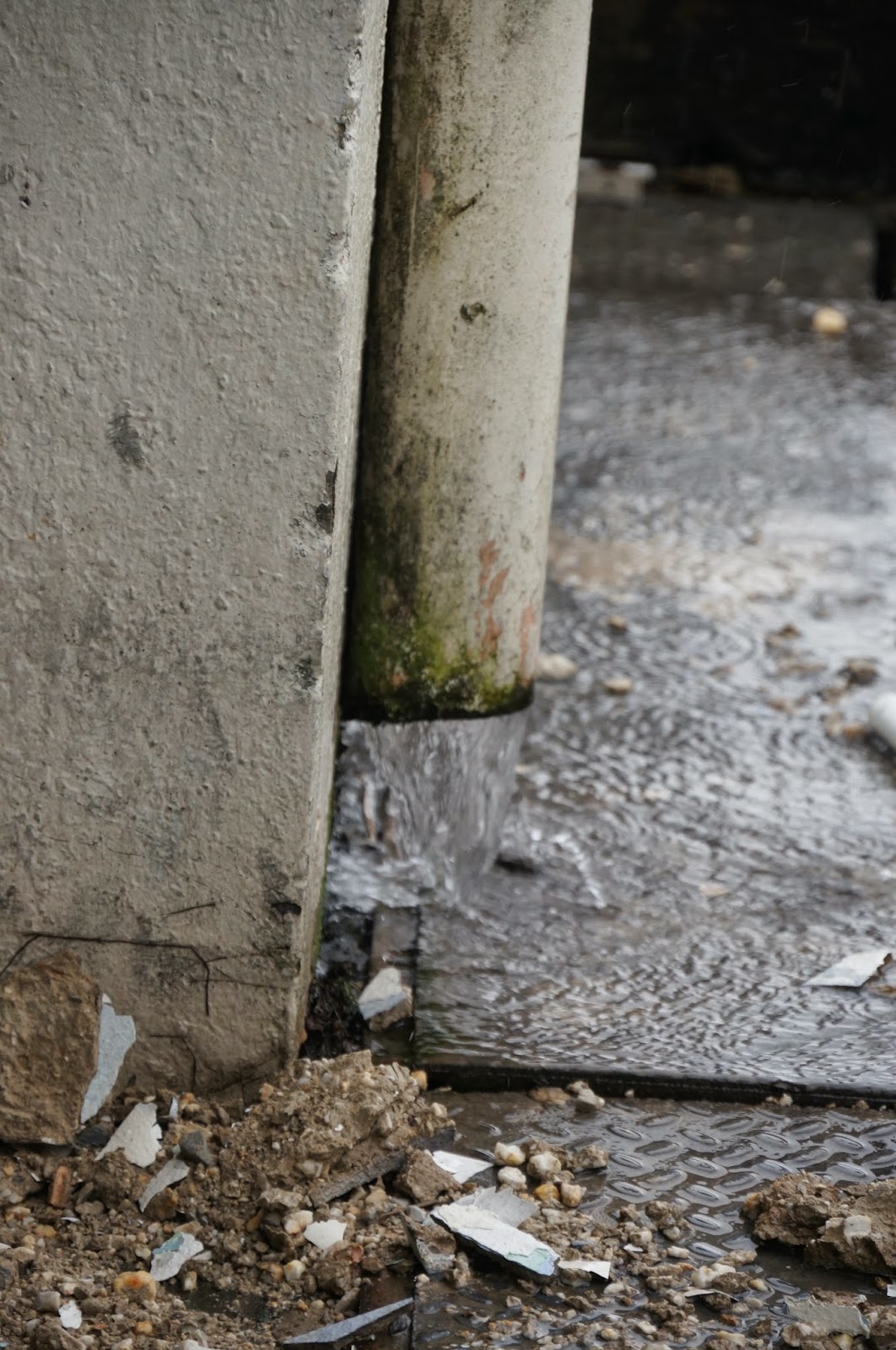Excavating
Rocks - Rip-able or Un-rip-able
Road
engineers often have to face the challenge on
deciding whether the roads they designed at hilly/ mountainous areas, can be excavated cheaply so as to
achieve safe and gentle road gradient for the road users. Of course, the
engineers can design to the safest gradient theoretically with the latest high
capacity excavating equipments and blasting, but the cost can be exorbitant
which renders the project not feasible. This is particular true for under
developed countries where budgets are limited. Modern living requires shortest
distance and safest road gradient between the two points. In the mountain
regions, mountains have to be excavated and valleys filled up or bridges built
to satisfy such needs. But deep excavation often encounters hard rocks and rock
excavation is expensive. It generally costs about US$2-4 to excavate and filling
of soils, but will cost more than US$10-20 to excavate rocks, depending on the
remoteness of the project sites. A balance has to be made between safety,
comforts, distance and costs. The knowledge of the machineries available
locally and rip-ability of local rocks become important so that the designers
can decide which lowest and most
economical excavated levels the local builders can achieve.
These photos show the 20 ton capacity
excavator being used to rip the rock. Obviously, this machinery is not suitable
for ripping as capacity is low and the energy splits between the many teeth of
the dipper. But as the rock is Shale, a soft rock, he may be able to rip
slowly. But much energy is lost through friction and heat. Perhaps, this
Contractor feels freer and economical to use his own available machine then to
rent a D8 bulldozer with the ripper from others.
On the local scene, D8L with the ripper, having 335 horse power and weighing 25 tons, is the standard machinery specified to
decide whether the rock is to be paid “rock rate”. If it is able to be ripped
by this machine, then it is considered “earth or non-rock”. If not, it is paid
“rock rate”. But in view of the high difference in cost, the Contractor
obviously wants to claim rock rate while the client wishes to pay only non-rock
rate. Thus Contractor may use an under-powered D8L to prove his point or even
ask the drivers to cheat on the use of gears or operations so as to show the
rock is not rip-able. Sometimes, road projects were abandoned because of this
controversy, especially if the engineers provide low quantities of un-rip-able rock
in the Contract. Of course, the design engineers can re-design the gradients to
minimise rock excavation, but the safety of the roads may be compromised
beside delay of projects. I remembered one road with a road gradient of 25% in
some stretch to a hill resort, became accident prone stretch within one month
of the opening. The cost and safety of the road is closely related.
But how to determine whether the rock is
rip-able or not? Engineers nowadays easily acquire road design software to come
out with beautiful lines, graphs, figures to even two decimals, cross-sections
and quantities. But to estimate the non-rip-able rock from this standard software is beyond its capabilities. The engineers have to decide which level is the cut-off point as even 10m away may be different.
The knowledge of geology is the first
pre-requisite. It is fortunate that the earlier geologists had come out with a Geological
Map of Sarawak, mapping all the different features, geological history and types
of rocks of Sarawak at different regions. These geologists of Sarawak
Geological Department were great enthusiasts, scientists and explorers, who
despite the inaccessible and difficult tropical terrains, ventured to the
ground, studied diligently under the hot sun for years during the last century
and came out with the geological reports and Maps, which had benefited the geologists/geotechnical engineers today, including me. I saluted them. The fourth edition
dated 1986 could be purchased from the Sarawak Geological Department and I often
referred to this Map.
Soil investigation is the next important
step. Although geological map is a helpful preliminary investigation, detailed
soil investigation will confirm the actual nature of the rocks beneath the
proposed road. After all, earlier Geologists used generally visual observations
of exposed outcrops, features, plus limited borehole drilling to come out the
geological map. Some local variations or intrusions of rocks may happen during
the tumultuous age of mountain buildings. Types of rocks will straight away
determine whether the rocks are rip-able or not. Igneous rocks, such as
Granite, Andesite, Gabbro, Basalt, Microtonalite, etc are generally difficult
to rip, unless they are thinly laminated. Sedimentary rocks such as Shale, Siltstone, Mudstone, etc are generally
easier to rip, but not the Limestone which is strongly bonded by chemical and can
reach a strength of exceeding 30N/sq.mm unconfined strengths. As of metamorphosed
rocks, Quartzite, Schist’s, Gneisses and Slates can be difficult to rip
depending on the lamination, mica content and degree of weathering. Drilling
boreholes can extract the rock cores beneath the ground for which the Geologists
and the Geotechnical Engineers can study the rock samples.
Together with Total Recovery Ratio (TCR) and Rock Recovery Designation (RQD),
some feelings on the rock rip-ability can be made but not absolute. Drilling
procedures, such as vibrations and water entries may produce totally shattered
samples, which appear easily rip-able.
Seismic survey is sometimes deployed for
larger road projects. Caterpillar (1983) and Smith(1986) had co-related
Rip-able Charts with their research on seismic survey, and are helpful in
determining the rip-ability of rocks. Seismic velocity travels 0.3km/s in loose
unsaturated soils, but reaches 6km/s in hard rocks. Generally, velocity of
2.0km/s is rip-able while >2.5km/s is unlikely. In between, it is the grey
area.
The most popular available excavating
machineries used for road construction in Sarawak are Caterpillar D6 bull dozers
and 20 tons excavators, mainly at lowlands and small hill areas. But D8 dozers
are only owned by some big construction companies. D8L is probably the most
common type which is specified in the local road specification. D8 Dozer had
evolved from 132 horse powers (hp) in 1932 to 335hp D8L in 1982 and 310 hp D8T
in 2004. Power is the most important factor to decide whether the rock is
rip-able.
Dozer had since developed into even more
powerful machineries, D9, D10 and even D11. These machineries are used to
excavate non-rip-able rocks. Although blasting and hydraulically mounted breakers/chisels
are another commonly deployed methods used to excavate hard rocks, but blasting
requires a lot of safety procedures and relevant approvals which quite often
cause delays. Chiselling is too slow for large quantities of rocks. Blasting is
often prohibited near dam sites and other sensitive Equipments installations. Therefore,
D9 and D10 dozers become the only options to excavate un-rip-able rocks in many
areas. These machineries were often used by the large and rich timber corporations
in the interior mountainous areas to build roads to transport their logs. With
the dwindling of the forests, these timber companies had switched to construct
highways which could deploy such machineries. In 1955, D9 had 286hp but by
2004, D9T had reached 410hp. But the most powerful D9 was 1980 D9L with 460hp. Komatsu D275A probably posed a strong
competitor to D9. In 1987, Caterpillar introduced 700hp D10 and 520hp D10N,
weighing 82-86 tons. Komatsu came out with D455A with 620hp and weighed 76
tons. By 1986, Caterpillar produced 770hp D11N weighing about 102 tons with
ripper, and by 2008 developed 850hp, 120 tons D11T. Komatsu responded with
1150hp D575A weighing 168tons. Such huge machines would be damaging to move on
the local roads. I had seen D9 and D10 in the timber concessions, but I am not
sure whether there is any D11 bull dozer in Sarawak.
Availability of large excavation
machineries does not mean cheaper rock excavation cost. These machineries are expensive to procure, and probably not only the manufacturers monopolise the market, the
owners also monopolise the local construction market. When budgets are
limited or the country is poor, Engineers have to propose a design of steeper
gradients with less excavation, slower speeds and longer routes. Road users have
to be more careful, drive slowly and ensure that their cars are maintained
road-worthy.
When you are poor, you cannot expect too much.
